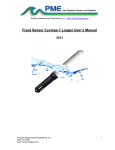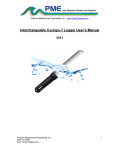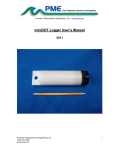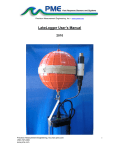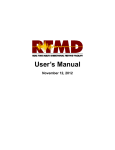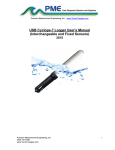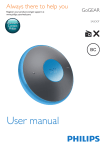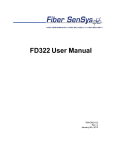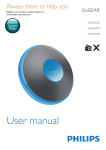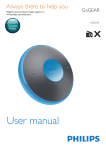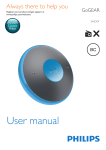Download User's Manual
Transcript
Precision Measurement Engineering, Inc. • www.pme.com User’s Manual 2014 Precision Measurement Engineering, Inc. (760) 727-0300 www.pme.com 1 Warranty 1-YEAR LIMITED WARRANTY ON miniDOT HARDWARE Precision Measurement Engineering, Inc. (PME) warrant that the miniDOT Logger shall be free of defects in workmanship and materials, under normal use, for a period of one year from the date of shipment. This warranty is made only to the original purchaser. In the event a miniDOT Logger covered by this warranty fails to operate according to our published specifications, then return it freight pre-paid to PME or an authorized Service Provider. PME will repair the unit at no charge to the customer and bear the cost of return shipment. Carefully pack all components, as the customer is responsible for any freight damage. This warranty does not apply to services or consumable / expendable items (such as batteries, fuses and ropes) required for general maintenance. Equipment manufactured by other companies (such as meteorology sensors, solar panels, etc) are warranted only to the limit of the warranties provided by their original manufacturer. PME makes no warranty, either expressed or implied, that the sensors will be operable after they are exposed to adverse environmental conditions, such as biofouling, oil fouling, freezing temperatures or others. This warranty is void if, in our opinion, the miniDOT Logger has been damaged by accident, mishandled, altered, or repaired by the customer, where such treatment has affected its performance or reliability. In the event of such treatment by the customer, costs for repairs plus two-way freight costs (no COD shipments will be accepted) will be borne by the customer. In such cases, an estimate will be submitted for approval before repair work is started. Items found to be defective should be returned to PME carefully packed, as the customer will be responsible for freight damage. Incidental or consequential damages or costs incurred as a result of the product malfunction are not the responsibility of PME. For all warranty or non-warranty returns please obtain, complete, and submit a RMA to PME. This RMA form may be obtained at http://www.pme.com/HTML%20Docs/RMAform.html. After submission of this form, then PME will respond with a RMA number. Please place this number on all shipments and related communications. Precision Measurement Engineering, Inc. (760) 727-0300 www.pme.com 2 Safety Information BURSTING HAZARD Should water enter the miniDOT Logger and come into contact with the enclosed batteries, the batteries may generate gas causing the internal pressure to increase. This gas will likely exit via the same location where the water entered, but not necessarily. The miniDOT Logger is designed to release internal pressure as the end cap is unscrewed, prior to the disengagement of the end cap threads. If internal pressure is suspected, then treat the miniDOT Logger with extreme caution. Revision History Date 20-JUL-2010 02-FEB-2011 14-MAY-2011 06-JUN-2011 08-JUN-2011 14-JUN-2011 16-JUN-2011 28-JUN-11 17-OCT-2011 14-DEC-2011 15-DEC-2011 19-DEC-2011 20-DEC-2011 10-JAN-2012 12-JAN-2012 19-JAN-2012 06-FEB-2012 10-FEB-2012 17-FEB-2012 14-MAY-2012 07-JUN-2012 17-JUL-2012 05-SEP-2012 10-SEP-2012 09-JAN-2013 21-MAR-2013 18-JUN-2013 17-JUL-2013 24-JUL-2013 05-NOV-2013 11-NOV-2013 03-MAR-2014 06-MAY-2014 16-JUL-2014 29-SEP-2014 Revision Description Initial document Revised to show better Dataturbine screen, added Vega, misc changes Extensively modified due to simplification of logger software Modified to describe startup with no 3 flashes if no CAL.TXT file found. This to be consistent with logger software change Added o-ring and SD card information, multiple plot info Minor wording changes; coin cell discharge description changed Added no backspace instructions to command description Now supplying cal.txt file Removed Export folder from miniDOT Plot software Corrected reference to section 2.9 to refer to section 3.9, added Sec 3.11 SD Card Corrected 19200 baud to 9600 baud in Appendix Corrected command instruction giving example for setting time Corrected correction of time instruction Added corrective action to flash description Added miniDOTControl information Added instructions concerning battery selection Updated for new Rev 2.09 firmware Revised to eliminate CAL.txt file and support new serial controls Revised to eliminate Hyperterminal instructions. Incorporated elevation/pressure entry in miniDOTPlot Added enhanced description of time zones and world time zone map. Added SD removal only with power off instructions Revised for new AA batteries and for stereo plug for RS232 Added picture of battery voltage measurement Added amount of SD card useage to battery life table Reworded miniDOTControl set time to describe Rev 1.06 miniDOTControl Reworded driver copy to say where to copy it Added words concerning opening and closing Added yeast instructions, removed sodium sulfite Added formatter download, reworded serial port driver to jspWin Reworded Chapter 2 Software installation Timezone entry in miniDOTPlot removed Included Copper Mesh Instructions Added instructions for the SD card retainer Added Storage When Not in Use to section 1.2 Removed the Copper Mesh Instructions Precision Measurement Engineering, Inc. (760) 727-0300 www.pme.com 3 CONTENTS Chapter 1 Quick Start 1.1 The Quickest Start Possible 1.2 A Few Details Chapter 2 Software 2.1 Overview and Software Installation 2.2 miniDOTPlot 2.3 miniDOTControl Chapter 3 miniDOT Logger 3.1 3.2 3.3 3.4 3.5 3.6 3.7 Overview Opening and Closing the Logger Electrical Connections and Controls File Close Button Battery Replacement File Management SD Card Precision Measurement Engineering, Inc. (760) 727-0300 www.pme.com 4 Chapter 1: Quick Start 1.1 The Quickest Start Possible Your miniDOT Logger has arrived completely ready to go. It is set to measure temperature and oxygen concentration once every 10 minutes and record 4 files of measurements daily. You need only turn on the power and deploy the logger. In this condition the miniDOT Logger will operate for most of a year before the internal battery is expended. At the end of the deployment period you need only to open the logger, press the File Close button, switch off the power, and remove the SD card. Your temperature and oxygen concentration measurements, together with a time stamp indicating the time the measurement was made, are recorded in text files in the DATA directory on the SD card. These files can be copied from the SD card onto any host computer. Follow these steps to start the deployment, logging DO & T once each 10 minutes: 1) Open the miniDOT Logger by unscrewing the white housing from the black end cap. Remove the housing completely. Inside you will see the circuit pictured below: Precision Measurement Engineering, Inc. (760) 727-0300 www.pme.com 5 2) Slide the power switch to the ON position. The LED will flash once. The miniDOT will now delay to the start of the next minute. Observe the LED for up to 90 seconds. Sometime during this period it will flash 5 times indicating that logging has begun. If it flashes continuously, then see Section 1.2 of this manual. 3) Inspect the o-ring seal for debris. 4) Close the miniDOT Logger by screwing the white housing back onto the black end cap. 5) Deploy the miniDOT Logger. Follow these steps to end the deployment 1) Recover the miniDOT Logger 2) Clean and dry all accessible surfaces except the ‘foil’. 3) Open the miniDOT Logger by unscrewing the white housing from the black end cap. Remove the housing completely, taking care that water does not drip onto interior surfaces of circuits or other items inside the logger. 4) Press the File Close button. The LED should begin continuous flashing. 5) Slide the power switch to the OFF position. 6) Unscrew the SD card retaining attachment. Remove the SD card by pushing down on it so the card is ejected. Use a card reader and a host computer to copy the files located in the DATA directory onto the host computer. These text files contain the measurements. (Note: SD card is not “hot swappable”. You MUST turn the power OFF before removing or reinserting the SD card. Damage may result if the power is not OFF.) 7) (Optionally) Run PME’s miniDOTPLOT.jar program to see a plot of dissolved oxygen, temperature and oxygen saturation, and to produce a concatenated file containing all the measurements. Remove the batteries if storing the miniDOT Logger for extended periods. 1.2 A Few Details The previous section gives instructions for sampling at 10-minute intervals. However there are a few additional details that will enhance use of the miniDOT Logger. Sampling Interval – The miniDOT Logger measures and records dissolved oxygen concentration and temperature at equal time intervals. The default time interval is 10 minutes. If a formatted SD card is placed in the miniDOT Logger and the power is turned on, then the logger will record every 10 minutes. However, it is also possible to instruct the miniDOT Logger to record at different intervals. This is accomplished by running the miniDOTControl.jar program supplied with the miniDOT. Sample intervals must be 1 or more minutes and must be less than or equal to 60 minutes. Sample intervals outside this range will be rejected by miniDOTControl. (miniDOT can sample as rapidly at 10 second interval if properly instructed. Contact PME.) Precision Measurement Engineering, Inc. (760) 727-0300 www.pme.com 6 Please refer to Chapter 2 for instructions on operating the miniDOTControl program. Sample Time – The miniDOT Logger records the time that each measurement of dissolved oxygen and temperature is made. It does this based on an internal clock. When your miniDOT Logger arrives it is set by PME to UTC (formerly known as Greenwich mean time (GMT)). Subsequent PME software implements conversion to local time. The miniDOTControl.jar program allows you to set miniDOT time based upon the host computer’s time. This is automatically translated to UTC based on settings within the host computer. The miniDOT Logger internal clock will drift in the <10 ppm range (< about 30 seconds/month) so you should plan to reset it occasionally. Please refer to Chapter 2 for instructions on operating the miniDOTControl program. File Information – The miniDOT Logger software creates 4 files daily. The number of measurements in each file will depend upon the sample interval. Files are named by the time (Unix epoch 1970) that the file is opened based on the logger’s internal clock and expressed in hexadecimal format. Cleaning the Sensing Foil –The sensor can be cleaned at regular intervals depending on the fouling condition at the site. The cleaning procedure of the sensor spots should be done with caution so that the protective coating is not removed. If the fouling is calcareous it can normally be dissolved with household vinegar. Another substance that can be used is commercially called muriatic acid, which is a 5% HCl solution (dilute solution by 50% should be tested to see how well it dissolves growth before using a stronger concentration). If needed, the Optode can be submerged in vinegar/HCl over night, or longer. If the marine growth remains, then use Q-tips to gently wipe it off after it has been softened by soaking in vinegar/HCl. After cleaning the sensor it should be rinsed well in clean tap water before storing or reuse. You can also use methanol and ethanol for the cleaning procedure. Do not use other organic solvents such as acetone, chloroform, toluene since these and others will damage the foil. The sensor membrane can also be cleaned using a 3% H2O2 solution or rinsing it with ethanol. The delrin case of the miniDOT Logger can be gently scrubbed. Precision Measurement Engineering, Inc. (760) 727-0300 www.pme.com 7 AA Lithium Battery Life – The miniDOT Logger consumes battery power mostly from the measurement of dissolved oxygen, but also slightly from simply keeping track of time, writing files, sleeping, and other activities. The following table presents the approximate endurance of the miniDOT Logger when powered by the Energizer L91 AA lithium / ferrous disulfide batteries supplied by PME: SAMPLE INTERVAL (minutes) Main AA Battery Life (days of sampling) Number of Samples 1 10 60 180 days 270 days 300 days 259,000 38,000 7,200 Fraction of SD Card Used (%) 0.6 0.1 0.06 Keep a general record of miniDOT Logger number of samples. It is not possible to accurately tell the charge state of a lithium battery from measurements of its terminal voltage. If you have a general idea of the number of samples already obtained on a battery, then you can make a guess as to how many more samples remain. The numbers in the table above are at the time of this writing only estimated based on published battery capacity. However, these AA batteries are easily available and relatively inexpensive compared to the cost of the miniDOT. PME suggests you replace the batteries as often as possible. Monitor terminal voltage. You cannot tell from terminal voltage how long the battery will last, but you can tell if it will die sometime really soon. The Low Drain Performance plot below gives an estimate of terminal voltage for both lithium and alkaline batteries. Your measured voltage will be 2X what is shown below since there are two batteries in series within the miniDOT. You can operate batteries down to about 2.4 Volts (for two in series). Measure the series voltage as shown in the picture below. Your batteries are dead if this measurement is less than 2.4 Volts. Precision Measurement Engineering, Inc. (760) 727-0300 www.pme.com 8 You may also use alkaline AA batteries such as Duracell Coppertop. They will not last nearly as long, especially at low temperatures, but will likely be adequate for several weeks at 10-minute interval. When replacing batteries use only fresh batteries. Don’t mix battery types. If one battery differs in type or charge level from the other and the miniDOT runs them to full discharge, one battery may leak. Err on the side of caution when planning your deployment. The recommended battery is Energizer L91. See this link for information including performance at low temperatures: http://data.energizer.com/PDFs/l91.pdf The figure below gives a very general idea of terminal voltage vs lifetime. Service life in hours is incorrect since miniDOT draws far less than 50 mA continuously but the general shape of the voltage vs time gives an estimate of life remaining. This plot is taken from the manufacturer’s specification. The plot is for a single battery. Double the voltages shown to give the terminal voltage as measured in the picture above. Coin Cell Battery Life – The miniDOT Logger uses a coin cell for backup of the clock when the power is switched off. This coin cell will supply roughly 2 years of clock operation, but this is only required if the main power is off. Should the coin cell discharge it must be replaced. Contact PME. Recalibration – The miniDOT Logger will maintain its calibration without the necessity of adjustment by the user. Loggers should be returned to PME for recalibration. We suggest that this be done every ½ million samples. Precision Measurement Engineering, Inc. (760) 727-0300 www.pme.com 9 O-Ring and Seal – When the cover is screwed on, it passes along the o-ring located in the end cap several revolutions. Keep this o-ring lightly lubricated with silicone grease or oil compatible with buna-N o-ring material. When the miniDOT Logger is opened after deployment, a small number of water drops are deposited on the inner surface of the o-ring. When the pressure housing is screwed back on these drops become trapped inside the miniDOT Logger. Be sure to carefully dry the o-ring and adjacent surfaces (especially underneath) prior to closing the miniDOT. Re-lube the o-ring at this time. SD Card – The SD card is secured with a retaining attachment. This is to keep the card from potentially being ejected from its socket if the miniDOT Logger is dropped on its pressure housing end. The logger will be unable to log should this occur. PME recommends that the SD card be secured by the retaining attachment. This attachment should be secured by the provided screw and lock washer. To remove the SD card, simply unscrew the retaining attachment from the miniDOT chassis. The SD card is not “hot swappable”. You MUST turn the power OFF before removing or reinserting the SD card. Damage may result if the power is not OFF. Use only 2 GB SD cards. LED Indications – The miniDOT Logger performs various tests as it begins logging operations. If any test fails the software flashes the LED light and re-conducts the test. In general if a test fails once it will continue to fail and the LED light will continue to flash. The following table gives the number of flashes and the reason these flashes appear. LED Flash # 1 2 3 4 5 Reason Corrective Action Normal. Presented immediately after power is switched on. Indicates that the CPU has started its program. Error. No SD Card or SD card not completely plugged in. None required. Normal operation. Error. Requested sampling interval less than 1 minute or greater than 1 hour. Error. Clock not initialized. Normal, presented once after roughly one minute, indicating that the miniDOT Logger is starting logging operation. Precision Measurement Engineering, Inc. (760) 727-0300 www.pme.com Plug SD card correctly. Install new SD card. Re-format SD card (Sec 3.7). Turn power off before unplugging/plugging SD card Contact PME Reset clock using miniDOTControl program (Sec 2.3) None required. Normal operation 10 Verifying Calibration – You may from time to time want to verify the calibration of your miniDOT. Do this by placing the miniDOT in a 5 gallon bucket containing 4 gallons of fresh water to which you have added 2 fluid ounces of household bleach. The miniDOT sensor end (black) is heavy and the miniDOT will tend to flip so that this end is down. Prevent this somehow. miniDOT must be placed in the bucket with the sensor end upwards. Otherwise bubbles will accumulate in the sensing end and miniDOT will not sense water DO correctly. Use an aquarium pump and air stone in the water to provide a bubble stream. Record measurements for several hours or a day but in any event long enough for the miniDOT temperature to come to equilibrium with the water. During the experiment find the local air pressure, either from measurements or from a local weather station. Watch out... weather stations often report barometric pressure referenced to sea level. You must determine the barometric pressure at your elevation. An additional experiment is to additionally place ice in the bucket, mixing until the water temperature is close to zero degrees. Remove the ice. Place the bucket on a towel or cardboard and cover with a towel. Record for 24 hours as the bucket temperature gradually returns to room temperaure. You may also remove the air stone and gently mix 2 packets of baker’s yeast into the bucket. The water must be only slightly warm to the touch but not more than 30 deg C. These organisms will deplete all the dissolved oxygen in the water. Cut a disc of plastic film just large enough to lay on top of the water. Place this on top of the water. Do not stir or bubble after placing the film. Record measurements for a hour or so. Precision Measurement Engineering, Inc. (760) 727-0300 www.pme.com 11 Use miniDOT plot to examine the measurements. Saturation values should be very close to 100%, depending upon the accuracy that you have determined barometric pressure. If you placed ice in the bucket then saturation values will still be 100% but you will see the DO concentration and temperature change greatly. The recorded data when using yeast should show 0% saturation and 0 mg/l dissolved oxygen concentration. In practice miniDOT often reports slightly positive values, but within the accuracy of the miniDOT. Closing and Opening – Close and open miniDOT like you would a flashlight: open by unscrewing the white cylinder from the black end cap. Close by screwing the white cylinder on. When closing, do not tighten the white cylinder. Just screw it on until it makes contact with the black end cap. See Chapter 3 for more instructions. Please DO NOT remove the stainless steel screws in the black end cap. There are no user serviceable parts here. If the screws are removed you will damage the miniDOT and it will have to be returned for repair. Storage When Not in Use – Remove the batteries. Keep the black end covered with the cap supplied by PME. If the cap is lost, cover the end with aluminum foil. There may be an calibration effect of ambient lighting so attempt to keep ambient light from reaching the sensing foil as much as possible. Precision Measurement Engineering, Inc. (760) 727-0300 www.pme.com 12 Chapter 2: Software 2.1 Overview and Software Installation The miniDOT Accessory Kit includes software to concatenate and display miniDOT Logger data files, miniDOTPlot.jar, and to control the miniDOT, miniDOTControl.jar. miniDOTPlot displays plots of miniDOT measurements. miniDOT Control enables selection of sample interval and setting the miniDOT internal clock. miniDOT software operates on a Windows PC computer. Both 32 and 64 bit computers are supported. Software is supplied on CD or in a zip file. Copy or unzip to any folder on your computer’s hard drive. The software will contain these files and folders: Name miniDOTPlot.jar miniDOTControl.jar MoreMemory.bat jspWIN.dll 32 Bit PC Serial Driver 64 Bit PC Serial Driver Manual xxxxxxxxx.pdf Type Java executable Java executable Windows batch Windows dll Folder Function Plot miniDOT measurements, concatenate these into CAL.txt file Set time, set sample interval. Folder Contains 64 bit version of jspWIN.dll PDF document This manual Invoke miniDOTPlot with more memory for really large measurement sets Interface java to Windows COM port. The default is 32 bit. Contains 32 bit version of jspWIN.dll miniDOTPlot and miniDOTControl are Java language programs that require the host computer to have the Java Runtime Engine V1.6 (JRE) or later installed. This engine is commonly required for internet applications and will likely already be installed on the host computer. You can test this by running miniDOTPlot. If this program displays its graphical user interface then the JRE is installed. If not then the JRE can be downloaded via internet from http://www.java.com/en/download/windows_xpi.jsp miniDOTControl communicates with the host computer’s serial port. It requires a serial port driver, jspWin.dll. The jspWin.dll in the files supplied is the 32 bit version. If your computer is a 64 bit computer, delete jspWin.dll. In its place copy the jspWin.dll from the 64 Bit PC Serial Driver folder. The correct (32 or 64 bit) jspWin.dll must be present in the same folder as miniDOTControl. Precision Measurement Engineering, Inc. (760) 727-0300 www.pme.com 13 If your computer does not have a serial port (these are called COM ports on Windows computers) you must supply a serial-to-USB adapter. These can be purchased from PME or from some other source. These adapters usually require that you install a driver. For PME’s adapter follow instructions supplied with the adapter. 2.2 miniDOTPlot Begin program operation by clicking on miniDOTPlot.jar. When miniDOTPlot runs it presents the screen shown below. miniDOTPlot reads and concatenates the files recorded by the miniDOT Logger. The software will also compute oxygen saturation from dissolved oxygen measurements. To do this software must know the air pressure and salinity. It calculates air pressure based on elevation of the water surface above sea level or uses the barometric pressure you enter if Barometric Pressure is selected. If elevation is entered, no compensation for weather-induced barometric pressure variation is made. Enter elevation or barometric pressure. Enter water salinity. Select the folder that contains the files recorded by miniDOT. These files have file names similar to 51BA1F98.txt. This could be the DATA folder on the SD card from the miniDOT or it could be any folder on your computer’s hard drive where you copied the miniDOT files. This folder must NOT contain any other files besides miniDOT data files. Press ‘Process’ to begin program operation. The software reads all miniDOT Logger data files in the import folder. It concatenates these, computes oxygen saturation and compensates for salinity, and writes the result into a file named CAT.TXT in the same folder where it finds the miniDOT data files. This is a text file and looks similar to the following: Precision Measurement Engineering, Inc. (760) 727-0300 www.pme.com 14 The software also produces a plot of oxygen, temperature, and saturation vs time. You may zoom this plot by drawing a square from upper left to lower right (click and hold left mouse button) that defines the zoom region. To zoom completely out, attempt to draw a square from lower right to upper left. Right click on the plot for options such as copy and print. The plot can be scrolled with the mouse while the Control key is held depressed. Different DATA Folders can be selected during one session of the program. In this case the software produces multiple plots. Presently the plots are presented exactly on top of each other and so when a new plot appears it is not obvious that the old plot is still there. It is. Just move the new plot to see it. The software can be re-run at any time. If an already processed DATA Folder is selected the software simply reads the miniDOT Logger measurement files again and, after asking permission, overwrites the CAT.TXT file. Precision Measurement Engineering, Inc. (760) 727-0300 www.pme.com 15 2.3 miniDOTControl Begin program operation by clicking on miniDOTControl.jar. Software presents the following screen: Be sure to follow these instructions. First, connect the miniDOT to the computer COM port (or USB – Serial port adapter if using this). See Chapter 3 for instructions. Next turn the miniDOT on. At this time miniDOT determines if it is connected to the serial port or not. If connected, it illuminates the LED continuously and it becomes responsive to commands sent over the serial port. If not, it begins measuring. After you click OK the miniDOTControl user interface appears. The host computer’s serial ports will appear in the Select COM port drop-down list. You must identify the serial port connector on the host computer that corresponds to Precision Measurement Engineering, Inc. (760) 727-0300 www.pme.com 16 the list entry. Most lap-top computers will not have a serial port. If this is the case a serial port can be added by purchasing an inexpensive serial-to-usb converter. See manufacturers instructions for installation of this device. PME sells a kit containing this converter. Click on the Connect button. The software will contact the logger. If the connection is successful the button will turn green and display “Connected”. The Serial Number and other parameters will be filled in from information taken from the miniDOT. If the host computer is connected to the internet, the current difference between an internet time server’s time and the miniDOT Logger internal clock will be displayed next to the Set Time button. If this difference is acceptable the clock need not be set. If the computer is not connected to the internet a message will appear and the Set Time button will not be enabled. To set the clock, press the Set Time button. Software will set UTC time based upon an internet time server’s clock. Time set will replace the time error displayed. The current miniDOT Logger sample interval will be displayed next to the Set Sample Interval button. If this interval is acceptable the interval need not be set. The interval can be set without the host computer being connected to the internet. To set the interval, enter a interval not less than 1 minute and not greater than 60 minutes. Press the Set Sample Interval button. Switch the miniDOT Logger off and disconnect the serial cable. Close the miniDOT Logger, close the miniDOTControl program. Your miniDOT Logger’s internal clock and sample interval are now set to UTC and the interval you entered. Precision Measurement Engineering, Inc. (760) 727-0300 www.pme.com 17 Chapter 3: miniDOT Logger 3.1 Overview All of the miniDOT Logger measurements pass from the sensors onto the SD card it contains. Measurements may flow from the logger to host computer by removing the SD card and copying the contents. Customers will be required to open the logger each time measurements are obtained. This chapter describes the logger internal features. 3.2 Opening and Closing the Logger The logger circuitry is contained in a waterproof housing that must be opened. The housing is opened by unscrewing the white pressure housing from the black end cap. Turn the pressure housing counter clockwise relative to black end cap. Close by reversing this procedure after being sure that the o-ring is free from debris. Lube oring occasionally with grease intended for buna-N o-ring material. Please attempt to handle the miniDOT only by the aluminum chassis, without touching the circuit card. When closing the miniDOT just screw the white cylinder onto the black end cap until the cylinder just touches the end cap. Do not tighten! miniDOT tends to get a little tighter during depolyment. If you can not open miniDOT by yourself, find another person with strong hands. This person should grip the black end cap while the other person turns the white cylinder. Do NOT remove the stainless screws in the black end cap. If this is done the miniDOT will be permanently damaged and must be returned to be repaired. Precision Measurement Engineering, Inc. (760) 727-0300 www.pme.com 18 3.3 Electrical Connections and Controls Removal of the cover reveals the logger connections and controls, shown below. The SD Card contains data files and the calibration file. These are described elsewhere in this manual. (Note: SD card is not “hot swappable”. You MUST turn the power OFF before removing or reinserting the SD card. Damage may result if the power is not OFF) The LED Light is a yellow or green LED. This is used to indicate different features described elsewhere in this manual. The File Close Button causes the program to save the current file and halt data logging. Press this button prior to switching power off. The RS232 Connection allows communication between the logger and an external computer. Communication parameters are 9600 baud with 8 bits, no parity, and one stop bit. This port is used to connect to PME’s miniDOTControl program. The On/Off Switch connects or disconnects battery power to the logger. In the ‘Off’ position the logger is completely without power except for the clock circuit. Note that Precision Measurement Engineering, Inc. (760) 727-0300 www.pme.com 19 ‘On’ and ‘Off’ positions are marked in white letters on the circuit board nearby the On/Off Switch. The Main Batteries (2 X AA on side opposite to pictured side above) provide main power to the miniDOT Logger. Note the positive (+) terminal. 3.4 File Close Button The logger records individual measurements to the SD card file when the measurement is made. After each measurement the file remains open. If the power fails or is switched off while the file is open, then the file information is lost. Files are recorded 4 times daily so only as much as 6 hours of measurements are at risk. The user must inform the miniDOT software that the power is about to be switched off by pressing the File Close button. The software will detect this action and close the presently open file. Thereafter the logger will halt its mission and flash its LED repeatedly. 3.5 Battery Replacement Be sure that the replacement battery is compatible with miniDOT. PME recommends Energizer L91 AA size batteries. You may also use AA size alkaline batteries such as Duracell Coppertop. http://data.energizer.com/PDFs/l91.pdf Improper replacement of the battery will damage the miniDOT Logger. Follow these steps: 1) 2) 3) 4) 5) 6) 7) 8) If the logger is logging, press the File Close button. Move the On/Off Switch to the Off position. Remove the depleted batteries noting the position of the (+) terminal. Use only new, fully charged batteries of the same type. Install fresh batteries with the (+) position the same as the removed battery. The (+) position is also marked on the inside of the battery holder. Review the battery installation. Be sure the (+) end of the battery is properly positioned!! Move the power switch to the On position. The miniDOT Logger LED Light should flash once to indicate that it is beginning operation. If you install the batteries backwards and turn the power on, then you should plan to purchase a new miniDOT Logger. Precision Measurement Engineering, Inc. (760) 727-0300 www.pme.com 20 3.6 File Management The miniDOT Logger writes 4 data files daily onto the SD card. These are text files that contain the measured data. These files contain the serial number of the miniDOT Logger that wrote the file and also a time stamp for each measurement. The miniDOT Plot software reads all these files and produces a CAT.TXT file that contains the original data plus extra information. The recommended method of file management is the following: 1) Deploy the miniDOT Logger for a period, and recover it. 2) Unscrew the SD card retaining attachment. Remove the SD card and place in a card reader on a host Windows computer. 3) Run miniDOT Plot, selecting the DATA directory on the SD card. This creates the CAT.TXT file in the SD card DATA directory. 4) Create a folder on the host computer for this miniDOT Logger deployment. Copy all files in the SD card DATA directory to this folder. Keep separate miniDOT Logger deployments in separate folders. Keep folders grouped into a folder for the specific miniDOT serial number. 5) Delete all files in the SD card DATA directory. 6) Replace the SD card in the miniDOT. Tape in place. File management may be handled in other ways, but in any event be sure that the SD card DATA folder is empty prior to beginning a deployment. If it is not empty nothing bad happens but unpredictable miniDOT Logger operation may occur if the number of files becomes large, roughly over 1000 files. 3.7 SD Card miniDOT is supplied with a 2 GB SD card. Use only SanDisk 2 GB SD cards. Cards manufactured by other manufacturers may work also but PME has tried SanDisk. In any event use only 2 GB capacity cards. Larger capacity cards do not work since they are formatted in a different way. The SD card is secured with a retaining attachment. To remove the attachment, simply unscrew it from the miniDOT chassis. Precision Measurement Engineering, Inc. (760) 727-0300 www.pme.com 21 Format every card prior to using with miniDOT. Format cards only on a PC computer running a Windows operating system. Other computers or operating systems may work but PME has tried only Windows. When formatting, select FAT, not NTFS or FAT32. Do not provide a volume label nor select Quick Format. Here is the correctly set Windows 2000 Format dialog: Press Start! It may happen that Windows drops the ability to format SD cards or that it drops the ability to format SD cards with FAT16. Should this be the case a SD-specific formatter can be downloaded from https://www.sdcard.org/downloads/formatter_4/eula_windows/ This formatter is designed to format 2 GB SD cards. It installs very easily and is easy to use. It is probably better to use this formatter than to depend upon Windows. When the program runs it presents this screen: Precision Measurement Engineering, Inc. (760) 727-0300 www.pme.com 22 Be sure the Drive is properly selected for your SD card. Click on Format. Done! Note: SD card is not “hot swappable”. You MUST turn the miniDOT power OFF before removing or reinserting the SD card. Damage may result if the power is not OFF. End of Manual. Precision Measurement Engineering, Inc. (760) 727-0300 www.pme.com 23


























